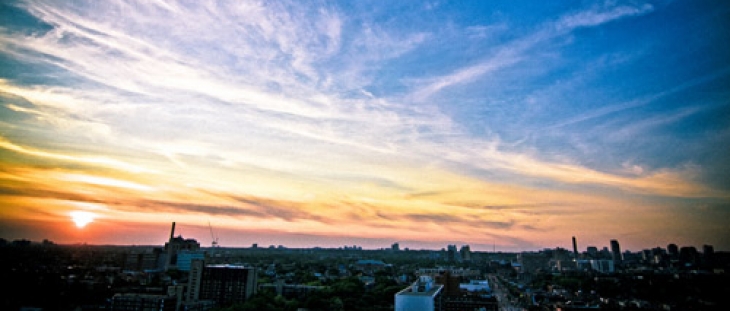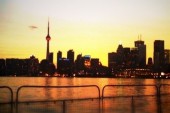
(Photo: Mandeep Flora/Toronto Standard Flickr Pool) A 25 minute walk from my parents’ house in Woodbridge just north of the city, there are not one, but three shopping plazas replete with a supermarket, a Winner’s, a Kelsey’s and a Starbucks. The enormous, almost comical sprawl of Vaughan Mills Mall is only a 10 minute drive away, as are both a Walmart and an Ikea. And all around are row upon row of brick houses with manicured lawns overlooking wide, busy roads with nary a bike lane or independent coffee shop in sight. All of which is to say, it’s perfect. Perhaps that’s not what you were expecting to read. After all, the conversation around cities has clearly shifted away from car-friendly sprawl toward urbanism.
The suburbs, we are now relatively sure, are not only environmentally unsustainable mistakes of the last century, they’re just generally bad for us. Yet at the same time, there’s a large gap in discussions about Toronto’s suburbs. Surprisingly to some, many of the people living in places like Peel or Scarborough do so voluntarily–almost as if they like it or something.
Moreover, a very significant chunk of those suburbanites aren’t white and weren’t born in Canada, a fact that raises some rather sticky questions. To wit, as downtown scenesters badmouth the suburbs over bowls of Pho, are they ignoring the complexities of multiculturalism–or worse, dismissing them? I’d argue the answer to that question is “yes”, for two key reasons: first is the construction of the suburbs as ‘inauthentic’; and second is a whitewashed understanding of what that means for many immigrants. When you look at it, so much of the disdain for the suburbs is actually less about sound planning and is an evaluation of a particular lifestyle: the car-centric, big-box mentality that has become associated with mainstream culture. It’s not simply that the suburbs represent a less sound way to organize living space; they are a symptom of dumbed-down, consumerist 21st century society. The valourization of the city, then, is actually a flight from the inauthentic to the real, a rejection of the artificiality of Loblaws and Milestones in favour of a magical land of farmer’s markets, caf culture and bars that consider vodka a sin.
Sure, there are downsides to the city like noise, congestion or leaky Victorian apartments, but they are all worthy sacrifices for authentic living. But here’s the thing: longing for a return to the authentic can only occur in its absence. It’s a profoundly privileged, Western idea to want to forsake sterility for the ‘real and gritty.’ But the funny thing about being a immigrant is that it’s quite possible you have had more ‘authentic’ experiences than you know what to do with. Affluent white westerners might find the thrall of Mumbai or the crowds of Hong Kong or the heat and dust or Iraq thrilling and somehow true; they might also like the more moderate downtown Toronto version of that bustle for the same reasons. But once you leave those places, the appeal of the North American suburb is precisely what we are supposed to hate: you have your own space in a clean, uniform neighbourhood and you drive your own car to an air conditioned office. What white hipsters call ‘sterility’ and ‘emptiness’ is the appeal of the suburbs for many immigrants, in large part because they are not clamouring for a return to the authentic; it’s that they realized that the authentic, organic experience so sought after by ‘the downtown elite’ is a kind of social myth that presents certain ideals as ‘universal.’ People get really uptight when you say something like this because they take it to mean “immigrants are satisfied with the not-as-good; they just don’t know any better.” But it’s something quite different: it’s that many immigrants choose to do something as wild and crazy as define what’s ‘good’ by their own desires and interests.
If you’ve once lived in a developing nation, sterile can feel good. Uncluttered is good. Cars are good. Cultural difference does not simply mean we eat different food; it means we have different values. That this represents an enormous challenge to those looking to promote urbanism for very good reasons doesn’t make it any less true. There are many legitimate grounds on which to dislike suburbs, both personal and political. Hey, I’m writing this sitting in my apartment in Seaton Village. I made my choice. But by expressing disdain for the suburbs in culturally universal terms that elide how people evaluate the suburbs for themselves and by a different yardstick, we miss a crucial aspect of the whole urban-suburban divide. After all, there’s a lot more going on the suburbs than most downtowners seem to think. Rob Ford’s ward of North Etobicoke, for example, is a veritable hotbed of cultural hybridity and complexity. There is, to misappropriate Gertrude Stein, very much a there there. But more than anything, the suburbs are full of people who are getting a bit sick of being told that the dream they’ve worked so long and hard to realize is somehow a mistake or an aberration, ideas that only get more unsettling when spouted by privileged, white people. And if we are to move to a sustainable, populist version of urbanism that is truly multicultural and Canadian, then we are going to have to learn to appreciate and adapt to the cultural gaps that we not only now ignore, but deride and denigrate. The Ethnic Aisle, a blog about race and ethnicity in the GTA, is holding a ‘Suburbs vs. Downtown’ event on Monday September 26th at 6pm at The 519 to discuss the divide between the city and the ‘burbs and what it has to do with differences in culture and identity. Details of the event can be found here.
____
Navneet Alang is a tech critic for Toronto Standard. Follow him on Twitter: @navalang.
For more, follow us on Twitter at @torontostandard, and subscribe to our newsletter.














